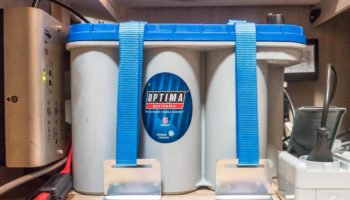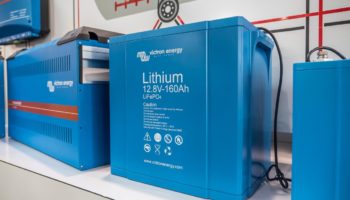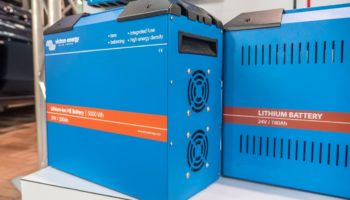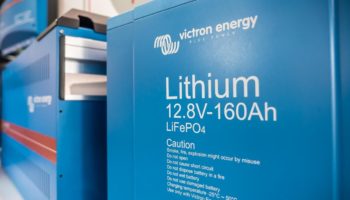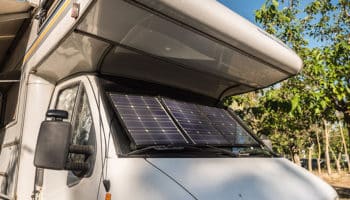Laptops, smartphones, lights and televisions all need one thing: electricity. Whether you live in a camper van like we do or just take it on holiday, we need the same thing for all the devices we take with us, namely electricity. Often 12 volts are enough, sometimes we need 220 volts. If you’re not on shore power, the electricity you need comes from the on-board batteries or supply batteries. In this article, I would like to show you what different types of batteries are available on the market, how they differ and which one is best suited for you.
Inhaltsverzeichnis
What is the point of an on-board battery or motorhome battery at all?
Almost every motorhome has at least two batteries on board. One is located in the engine compartment, this is the starter battery. This supplies the starter motor and the light in the driver’s cabin. The radio and other consumers in the front of the motorhome are also powered by this battery. When starting, a high current is drawn from the battery for a very short time. As soon as the engine is running, everything is supplied by the alternator and no more current is drawn. This battery (nothing else are the batteries in the motorhome), is therefore made to supply hundreds of amps for a few seconds. These batteries have a flat cycle. They should only be discharged 10-20 percent of their capacity. This is not the right battery to supply power to the various consumers in the motorhome body, such as lights, water pump, TV, satellite system. If there is no power connection nearby, you need a motorhome battery that supplies power over a longer period of time and does not need to be fully charged. And that’s exactly why there are extra supply batteries in the motorhome. These batteries are made to supply a few amps for many hours. These batteries have a deep cycle. They can be discharged between 50 and 80 percent of their capacity.
The most important: cycle stability and charging cycle
Accumulators are charged again and again. Manufacturers often specify the number of charging cycles as a value. A charging cycle can be the following:
- A battery is discharged by half twice and fully charged again each time.
- A battery is discharged by 20% and recharged, then discharged by
- 30% and recharged, then discharged by 50% and recharged. A battery is discharged by 100 % and fully charged again.
The number of charge cycles that the battery survives “relatively unscathed” is called the cycle number. If a manufacturer specifies 800 charge cycles, this means that the battery still has 80% of its capacity after 800 charge cycles. It will still function after that, but the storage capacity will continue to decrease. With on-board batteries, it is important that you can charge them as often as possible. Because everyone wants their batteries to last as long as possible. For this reason, the batteries used on board should be as cycle-resistant as possible. This characteristic, together with the cycle depth, is crucial and important. When you buy batteries, you should always keep this information in mind.
These different battery types are available
Batteries in motor homes, caravans, cars and also on boats today are still almost exclusively lead-acid batteries. These basically consist of a positive and a negative lead plate and an electrolyte liquid in between – diluted sulphuric acid (H2SO4). Marketing departments use all sorts of terms to describe batteries. Utility battery, body battery, solar battery are just a few. Don’t let this fool you. They are all batteries that are as cycle-resistant as possible, and they basically come in three different varieties:
- Wet batteries – as described at the beginning: a positive and negative lead plate and diluted sulphuric acid.
- Gel batteries – here the lead plates are thicker and the electrolyte is bound in a gel.
- AGM batteries – in these the electrolyte is bound in a glass fleece.
Recently, lithium technology has also found its way into motorhomes. With it, a new technology is increasingly entering the market, which I will discuss in more detail below. The more often new technologies are used, the cheaper they become. You know these batteries from your smartphone, model making or other electronic devices with rechargeable batteries. In the following, I will explain the individual battery types and also list the advantages and disadvantages.
Wet batteries
This type is constructed almost like a starter battery. The differences are the thickness of the lead plates and the alloy on which the lead is applied. Both of these factors significantly improve the cycle stability of the battery, making it suitable for use as a body battery. However, if these batteries are discharged too much, sulphation occurs. In this process, the lead sulphate crystals combine to form lumps on the surface. The free surface becomes smaller and smaller and the performance decreases because the electrodes conduct less and less. These lumps can also fall to the ground and lead to siltation. If the mud rises up to the electrodes, a short circuit occurs. This also occurs if the batteries are left unused for a long time. This short circuit will destroy the battery quite quickly. Wet batteries should therefore be discharged to no more than half their capacity. If you discharge them further, the battery will age much faster and break down much sooner. If you do not use your motorhome in winter, for example, connect it to the mains. Modern chargers then switch to trickle charge and thus maintain the battery! If this is not possible, then fully charge the battery once and then disconnect all consumers. Advantages: [su_list icon=”icon: plus” icon_color=”#47fa2b”]
- cheapest battery technology
- relatively simple charging technology is sufficient
[/su_list] Disadvantages: [su_list icon=”icon: minus” icon_color=”#fa2b31″]
- High-maintenance: the acid level should be checked regularly and water topped up.
- Outgassing: during operation, gases are produced in the battery which are discharged through a valve. This gas must also be discharged from the motorhome.
- Not leak-proof: the acid could leak. Therefore, the battery must be stored in an acid-proof container.
- Depth of discharge 50 % – 60 %: Wet batteries should not be discharged to more than half. The battery must therefore bring twice the capacity you need.
[/su_list]
Maintenance-free wet batteries
VRLA accumulators are a variation of the wet battery. This translates as “valve-regulated lead-acid battery”. These supply batteries are welded. They do not have small lids at the top for turning off and refilling acid like normal starter batteries. They only have a pressure relief valve. With these motorhome batteries, the electrolyte is thickened and therefore cannot flow out so easily. We use these in our motorhome. Advantages: [su_list icon=”icon: plus” icon_color=”#47fa2b”]
- cheapest battery technology
- relatively simple charging technology is sufficient
- low-maintenance and leak-proof
[/su_list] Disadvantages: [su_list icon=”icon: minus” icon_color=”#fa2b31″]
- Outgassing: here, too, gases can be produced in the battery during operation, which are discharged through a valve. This gas must also be discharged from the motorhome.
- Depth of discharge 50 % – 60 %: Wet batteries should not be discharged to more than half. The battery must therefore bring twice the capacity you need.
[/su_list] [su_box title=”Installing the solar system yourself” style=”soft” box_color=”#f6df7c”] You’ve always wanted to install a solar system on the roof of your motorhome, but don’t know exactly how? In this article, I’ll show you how to do everything yourself, including a shopping list and installation instructions. With a little manual skill, anyone can do it. Click here for the solar system on the motorhome instructions[/su_box]
Lead-gel batteries
As I wrote above, the electrolyte in these batteries is bound in a gel. Furthermore, these batteries have thicker plates. As a result, they can deliver electricity for much longer. But they also charge longer. They also have a better depth of discharge. The gases that develop in the battery are often prevented from escaping directly by the gel. Only a small amount escapes through a valve. However, as this is oxyhydrogen gas, there should be no sources of ignition near gel batteries. A special charger for gel batteries is needed for charging. They are also heavier than those with liquid electrolyte. They tolerate high temperatures much better than low ones. Lead-gel batteries are therefore not ideal for winter camping. They should also not be used as a starter battery, as they do not like large current draws. This fact also makes them not perfect for interaction with larger inverters, which you should bear in mind when operating batteries for 220 V appliances! Advantages: [su_list icon=”icon: plus” icon_color=”#47fa2b”]
- almost maintenance-free
- Encapsulated construction: they are absolutely leak-proof and do not leak.
- can withstand discharges of less than 70 %, but should be recharged quickly.
[/su_list] Disadvantages: [su_list icon=”icon: minus” icon_color=”#fa2b31″]
- Special charging technology necessary to avoid outgassing
- High weight
[/su_list]
AGM batteries
This type is an attempt to combine the two techniques mentioned above. They lie between the wet and gel batteries in terms of cycle stability. AGM batteries have a higher energy density and can therefore be lighter. And they can tolerate similarly high current draw as wet batteries. In AGM batteries, the electrolyte is contained in a glass fleece. The battery itself is encapsulated like a gel battery and thus leak-proof. It also hardly gasses out.
This type can be charged with higher voltages than the other two. However, you need a special charger that can charge AGM batteries. A temperature sensor is mandatory. The batteries react allergically to heat, which is generated during the charging process. Due to the low internal resistance of the batteries, they hardly discharge at all. They are therefore perfect for longer periods when the mobile is not in use. Advantages: [su_list icon=”icon: plus” icon_color=”#47fa2b”]
- less sensitive to deep discharge than wet batteries
- maintenance-free
- low self-discharge
[/su_list] Disadvantages: [su_list icon=”icon: minus” icon_color=”#fa2b31″]
- Special charging technology necessary
[/su_list]
Lithium batteries
These batteries use a different technology than the batteries presented so far. You may be familiar with them from your smartphone. It’s not quite the same technology, but it’s very similar. Which technology is it? Well, it’s called LiFePo4.
These batteries are superior to the lead-acid versions in every respect: they are smaller, lighter, store more current, can be deep-discharged without problems, recharge quickly and are maintenance-free. Actually, my recommendation should clearly go to LiFePo4 batteries for your motorhome. But it doesn’t, because they have one disadvantage: they are extremely expensive. While you can buy a 120 Ah wet battery for about 120 euros, a 90 Ah LFP battery costs 630 euros. Advantages: [su_list icon=”icon: plus” icon_color=”#47fa2b”]
- small and light
- maintenance-free
- trouble-free deep discharge possible
- no self-discharge
- fast charging
[/su_list] Disadvantages: [su_list icon=”icon: minus” icon_color=”#fa2b31″]
- Very expensive to buy
[/su_list] The high purchase price is well compensated by the high number of charging cycles in contrast to normal wet batteries. It is therefore worthwhile to look into this technology. [vcex_spacing size=”10px”]
Important parameters of batteries
After I have shown you the different types of batteries or accumulators, I would now like to go into a few important parameters: the capacity, end-of-charge voltage, maintenance voltage or charge retention. Final discharge voltage and open-circuit voltage.
Battery capacity
The different battery types have different depths of discharge:
- Wet batteries: 50 %
- Gel batteries: up to 70
- AGM batteries: up to 80
If you look for batteries, you will come across specifications such as C1, C5, C10 or C20. Since the capacity of a battery depends on the current to be drawn, these parameters exist. The higher the current drawn, the lower the total available capacity. C1 means that the total capacity will be withdrawn within one hour, C5 that the capacity will be reached within 5 hours when the battery is completely discharged. As an example, the different capacity values for a SBG 12-100 gel battery (100Ah):
- C1 = 60.7Ah, i.e. 60.7A can be drawn for 1 hour until complete discharge.
- C5 = 73Ah, i.e. for 5 hours 14.6A can also be drawn until complete discharge, i.e. the available battery capacity is 17% higher at the lower current draw.
- C10 = 82Ah, i.e. for 10 hours 8.2A can be drawn before the battery is completely discharged; the capacity is now already 26% higher than with one hour’s discharge.
- C20 = 100Ah (the nominal value of the battery), now 5A can be drawn for 20 hours, the capacity of the battery is now at its highest.
Charging end voltage
The end-of-charge voltage is the voltage that must not be exceeded during the charging process. If it is exceeded, grid corrosion occurs, which is noticeable by “gassing” of the battery. Highly explosive “oxyhydrogen gas” is produced and the battery is permanently damaged. While wet batteries can still halfway cope with briefly exceeding the end-of-charge voltage without being destroyed immediately, AGM and gel batteries react extremely sensitively to exceeding the end-of-charge voltage. The level of the end-of-charge voltage depends on the battery technology. Depending on the manufacturer, it is 14.7V for wet batteries and 14.4V for AGM and gel batteries.
Float voltage, charge conservation
The float voltage is the voltage that the charger should maintain after full charge to counteract the self-discharge of the battery. The float voltage is the same for all battery types and is normally 13.7 – 13.8V.
Discharge voltage
The end-of-discharge voltage is the voltage that must not be fallen below during discharging. If the battery is nevertheless discharged further, it enters the deep discharge range and is damaged.
Open-circuit voltage
The open-circuit voltage is the voltage that can be measured on the battery after at least 4 hours have passed since the last charge or discharge. It is an approximate measure of the battery’s state of charge.
How do I charge the batteries in the motorhome?
There are several ways to charge the body batteries:
- Power generator: Unfortunately, most power generators are very loud and thus extremely annoying for you and for the neighbours. In addition, such a generator often only supplies a little more than 12 volts. This is not enough to fully charge the batteries.
- Shore power: Almost all motorhomes charge the body batteries automatically when shore power is connected.
- Alternator: The alternator charges both the starter battery and the supply battery. However, this often does not work as desired. If the starter battery is full, the supply battery only gets a little current. In addition, the cables, which are often too thin, reduce the voltage below 14 volts. This means that the motorhome battery will never be full. This is where battery boosters come in handy. These transform the voltage back up to 14.4 volts. They also demand a constant high current from the alternator. This ensures that the body batteries are fully charged during longer journeys.
- Solar power: solar module(s) on the roof, plus charge controller and cable, and the batteries are charged as soon as the sun shines. We use this method and can stand freely for an unlimited period, even if there are a few rainy days. I have described how this works in the article Solar module on the motorhome.
Conclusion/ Recommendation to buy:
The most important tip: Never buy a starter battery as a body battery. I explained why in the article above. If you only have a small budget available, then a classic, cycle-resistant, maintenance-free wet battery is certainly right for you. The same applies if you don’t have any special requirements for the battery and your motorhome is moved often. I recommend the following products: [apn typ=”template” template=”tpl-2″ asin=”B00YG7Q4DU” tag=”cs-batterie-21″ tpl-stars=”1″ false=””] a little more capacity: [apn typ=”template” template=”tpl-2″ asin=”B00UBBA9YK” tag=”cs-batterie-21″ tpl-stars=”1″ false=””] or with 220 AH capacity [apn typ=”template” template=”tpl-2″ asin=”B00VZ457O4″ tag=”cs-batterie-21″ tpl-stars=”1″ false=””] If you operate an inverter in your motorhome, I recommend a lead-gel battery. I can recommend the following: [apn typ=”template” template=”tpl-2″ asin=”B077ZWC6S7″ tag=”cs-batterie-21″ tpl-stars=”1″ false=””] If your motorhome is parked more often because you only need it for holidays, then an AGM battery would be right for you. with 75 Ah: [apn typ=”template” template=”tpl-2″ asin=”B00TMORUPI” tag=”cs-batterie-21″ tpl-stars=”1″ false=””] with 100 Ah: [apn typ=”template” template=”tpl-2″ asin=”B00TMQPYM2″ tag=”cs-batterie-21″ tpl-stars=”1″ false=””] with 240 Ah: [apn typ=”template” template=”tpl-2″ asin=”B077ZWC6S7″ tag=”cs-batterie-21″ tpl-stars=”1″ false=””] Finally, when buying a battery, make sure that the poles are arranged in the same way as on your old battery and that the size is the same.
